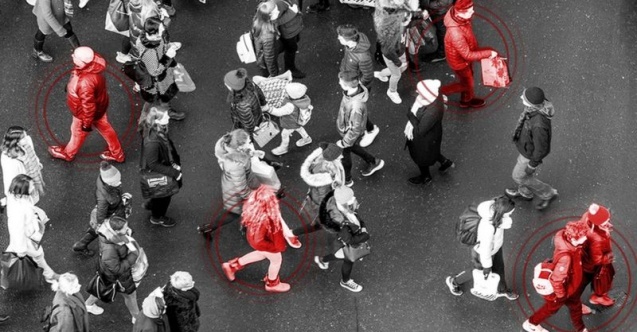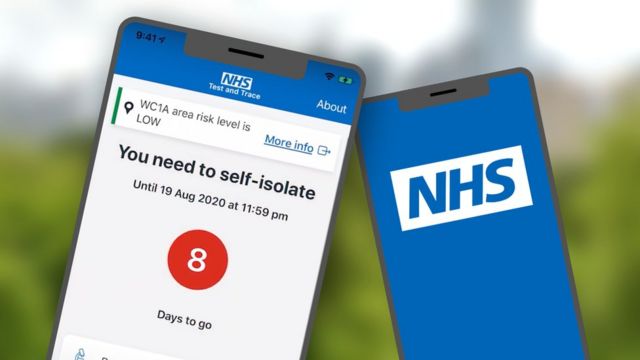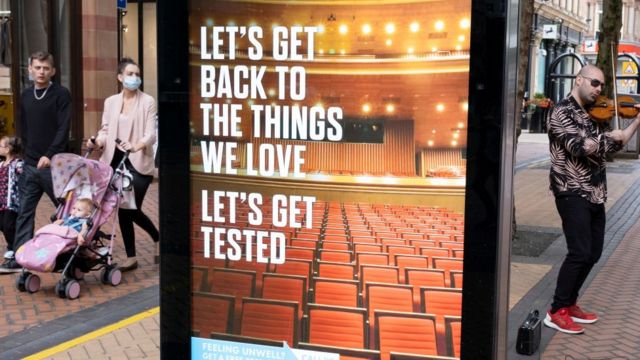Coronavirus: Why did Britain's Test-Contact system fail?
British Prime Minister Boris Johnson announced six months ago that the Test-Contact system developed against the coronavirus epidemic would be "first in the world". However, the research conducted by the BBC revealed that in some regions, only half of the contacts of those who tested positive for coronavirus could be reached and the system failed the most, especially in the places where the virus spread the fastest.

The BBC research also revealed in the government's meeting with private laboratories on testing that laboratories affiliated to the National Health Service (NHS) were not represented.
But the government insists that the system cuts Covid's rate of spread "beyond any doubt". He also notes that the NHS Test-Contact system is striving to further improve and improve its operation in the face of increasing cases.
The BBC spoke with government spokespersons, scientists and health officials who had been involved in the Test-Follow-Up-Contact system from the beginning, trying to determine where mistakes were made and, more importantly, whether the system could be corrected until the vaccines came to the rescue.
- The system is most ineffective in areas where it is most needed and still suffers from some wrong decisions initially made. The most important of these is that the existing public health services are ignored and private sector companies are placed directly at the center of the system, which conducts tests, analyzes and follows up contacts.
- The private companies that produced the devices under which the tests were carried out promised too much of what they could do and failed to deliver on their promises.
- The more local contact tracking by municipalities has not been achieved due to the problems caused by the central data system. This has led to the exclusion of local human resources and opportunities and much slower follow-up of contacts.
Success rate with data: 1st week of November
It is possible to explain why the Test-Contact system was ineffective, with figures for the first week of November.
It is estimated that 333,900 people were infected within a week.
141,840 people, 42 percent of them, were determined and uploaded to the Test-Contact system.
70 percent of these 141,840 people were reached and the details of 314 thousand people they had contact with were taken.
Half of the remaining ones (21 thousand people) did not give their contacts, and the other half could not be reached.
 Initial mistakes: the role of the private sector
Initial mistakes: the role of the private sector
The name of the system is NHS Test-Contact, but this does not mean that the entire service is linked to the National Health Service.
In fact, this perception has nothing to do with reality.
This system is run by a complex network of hastily assembling different programs. Private companies play an important role in the system both in terms of testing and monitoring contacts.
This means that local expertise and resources in the hands of the National Health Service, universities and local governments are out of use.
The seeds of this error were sown at a meeting with government officials to discuss the testing issue of a group of private companies on March 17, before the first closure measures were announced.
Among the companies attending the meeting were Randox and ThermoFisher, working in the field of health technology. However, the National Health Services Laboratories were not represented at the meeting where the tests were discussed and these institutions were not consulted.
Soon the direction of the business became clear, and the government asked private companies to set up large central laboratories outside of the existing public health system and research structures.
Most of the tests currently carried out within the UK are analyzed by a network of six mega-laboratories set up in this way.
The centers where the tests were collected by taking swab samples were created by the finance and technology company Deloitte.
A similar decision was made on the tracing of contacts. The center, which was created to monitor the contacts, is managed by a company called Sitel, and a nationwide staff of 18,000 contact trackers also works under the subcontractor company Serco.
There are around 3 thousand doctors in this team, some of whom come from public health institutions. However, this contact tracking only covers England within the UK. The regions of Northern Ireland, Scotland and Wales have created their own regulations.

The government says that tenders on these issues are held under conditions of urgency due to unforeseen events, but are still conducted in full compliance with the rules.
But the sources close to the decision processes at that time have some concerns.
A source speaking on the condition of anonymity said, "These tenders were signed and concluded at a record speed. Many of them do not even have performance-related penalties. The government was in a state of panic, closure measures were applied and we were under pressure from all sides. These are not the conditions that are suitable for making the right decisions."
Indeed, it turned out how true this was.
Promises companies can't keep
Many experts who were involved in that process hurried to government companies, "What can you do for us?" They say that nobody asked, but the question whether the answer given is realistic.
For example, the Randox company, which received a tender of about 500 million pounds from the Ministry of Health, was planning to recruit 200 new staff to speed up Covid-19 tests. The company had promised to produce 200 new test devices within 6 weeks of receiving the tender.
However, at that stage, even the first sample of the test device had not been made yet, and according to the previous estimates of the BBC, they were hoping to build only 10 per year.
As a matter of fact, not a single test device had yet been manufactured by September, and hundreds of people who were hired to make them were often sent back to their homes or had to sit idly by, as there was no work.
When asked to the Randox spokesperson, he said the company met all the government's expectations and did more tests than any laboratory in the UK.
Meanwhile, other companies were selling test equipment to public health care laboratories for use in hospital tests.
While all this was happening, the chemicals and equipment required for these devices were seized by the laboratories established by private companies and the hospitals were experiencing difficulties.
Central system made local resources unavailable
The daily test capacity in the UK, which was originally 2 thousand, has increased to 500 thousand today.
However, the system had difficulty shortening the time between taking a sample from a person and the result being known.
Many experts think the reason for this is a logistical problem due to the fact that everything is central.
Although there is a wide range of local facilities and potential personnel that can be used for tests, the introduction of giant laboratories established from scratch had an effect that slowed down the process. Samples taken from humans need to be transported to central laboratories, sometimes over distances as far as Edinburgh or Belfast, sometimes by plane.
Test target ok but is the goal achieved?
The government has often been criticized for clinging to numbers on tests.
By the end of March, 10 thousand test targets were set per day, 100 thousand test capacity per day by the end of April and 500 thousand test capacity per day by October.
But the question of who and for what these tests were conducted was overshadowed.
For example, despite constant warnings, coronavirus scans of hospital workers were not conducted unless they showed symptoms. Although there is evidence that a significant proportion of transmission occurs in hospitals, this is only just beginning to be done.
The seriousness of the problems related to the tests began to attract more attention of the public in September when the number of cases started to climb again. Laboratories could no longer respond to the increasing test demand.

Problems with monitoring contacts after testing
Tests are only the first part of the system. In order for these tests to work, people who are found to be infected must be isolated at home, and the people they come into contact with must be monitored and warned and quarantined.
A number of different problems have also been encountered in the contact tracing initiated in late May.
Eighteen thousand people, including 3 thousand doctors, were hired to monitor the contacts.
This might not be a problem if communication was successful. The problem has often been that these people cannot work at full capacity due to their central data and search system approach.
No initiative was given to the recruited persons for contact tracking, and their hands were given rules and texts that they should strictly follow.
For example, it was required to call all members of the family living in the same house separately and fill in the same forms one by one. Therefore, many families had to answer a large number of calls and complete forms even though they were not needed.
An executive level worker in contact tracing told the BBC that this made the system cumbersome, created enormous stress, and the contact workers were demoralized by the angry reactions from rebellious families.
The government says they are in the process of changing the approach on this issue.
Fails most where it is needed most
As a result, the system was able to perform well behind expectations.
Experts advising the government say that for test follow-up to be truly effective, 80 percent of those found to be infected need to be reached and recorded, then 80 percent of them must be reached and told to isolate themselves.

However, according to the data obtained by the BBC, only half of the contacts can be reached in the regions where the epidemic spread most rapidly, such as Bradford, Manchester, Blackburn and Nottingham.
Add to this the fact that the vast majority of those infected do not show any symptoms, and the helplessness against the spread of the epidemic emerges.
However, it is becoming increasingly clear that one of the most important factors in constantly falling behind the targets set in contact and tracking is the focus on the center, which leads to the unavailability of local resources.
In fact, in August the government recognized the need for more local resources. Local contact tracking teams would be formed. Municipalities started to act and establish these services, but they faced great difficulties in overcoming the central system.
According to the information provided by local government officials, data are sent late, repeated tracking files are received, they cannot enter the central data system, and all these delays transactions.
Insulation: the forgotten leg of contact tracking
While a £ 10 billion budget is set aside to track the infected and those around them in contact tracing, it seems that there is little thought about how to support people who are asked to isolate themselves.
It is not regularly kept to account how much of those who test positive or who have contact really isolate themselves. According to a study, the number of these people may be one in five people. The National Test-Tracking service thinks that this is half. But it is obvious that this is an important problem.
There are those who think that the quarantine period is too long and this is effective in breaking the rules. In some countries, it is sufficient for the contacts to stay in quarantine for 7 days, not two weeks.
In addition to all this, the question of how people who cannot work because they remain in quarantine can survive if financial support is not provided.
Contact trackers say that many people have to work to survive and are therefore reluctant to follow the rules.
Source BBC

Türkiye Cumhuriyeti'nde 14 Mayıs 2023'de yapılacak Cumhurbaşkanlığı seçimini kim kazanır?
| Takımlar | O | P |
|---|---|---|
| 1. Galatasaray | 32 | 87 |
| 2. Fenerbahçe | 32 | 85 |
| 3. Trabzonspor | 32 | 52 |
| 4. Beşiktaş | 33 | 51 |
| 5. Rizespor | 32 | 48 |
| 6. Başakşehir | 32 | 46 |
| 7. Kasımpasa | 32 | 46 |
| 8. Sivasspor | 32 | 44 |
| 9. Antalyaspor | 32 | 42 |
| 10. Alanyaspor | 32 | 42 |
| 11. A.Demirspor | 32 | 40 |
| 12. Samsunspor | 32 | 38 |
| 13. Ankaragücü | 33 | 37 |
| 14. Kayserispor | 32 | 37 |
| 15. Konyaspor | 32 | 36 |
| 16. Hatayspor | 32 | 33 |
| 17. Gaziantep FK | 32 | 31 |
| 18. Karagümrük | 32 | 30 |
| 19. Pendikspor | 32 | 30 |
| 20. İstanbulspor | 32 | 16 |
| Takımlar | O | P |
|---|---|---|
| 1. Eyüpspor | 30 | 68 |
| 2. Göztepe | 30 | 60 |
| 3. Kocaelispor | 30 | 52 |
| 4. Ahlatçı Çorum FK | 30 | 52 |
| 5. Sakaryaspor | 30 | 51 |
| 6. Bodrumspor | 30 | 49 |
| 7. Boluspor | 30 | 46 |
| 8. Bandırmaspor | 30 | 46 |
| 9. Gençlerbirliği | 30 | 44 |
| 10. Erzurumspor | 30 | 41 |
| 11. Manisa FK | 31 | 36 |
| 12. Keçiörengücü | 30 | 36 |
| 13. Şanlıurfaspor | 30 | 34 |
| 14. Ümraniye | 30 | 34 |
| 15. Tuzlaspor | 30 | 32 |
| 16. Adanaspor | 30 | 32 |
| 17. Altay | 31 | 15 |
| 18. Giresunspor | 30 | 7 |
| Takımlar | O | P |
|---|---|---|
| 1. M.City | 32 | 73 |
| 2. Arsenal | 32 | 71 |
| 3. Liverpool | 32 | 71 |
| 4. Aston Villa | 33 | 63 |
| 5. Tottenham | 32 | 60 |
| 6. Newcastle | 32 | 50 |
| 7. M. United | 32 | 50 |
| 8. West Ham United | 33 | 48 |
| 9. Chelsea | 31 | 47 |
| 10. Brighton | 32 | 44 |
| 11. Wolves | 32 | 43 |
| 12. Fulham | 33 | 42 |
| 13. Bournemouth | 32 | 42 |
| 14. Crystal Palace | 32 | 33 |
| 15. Brentford | 33 | 32 |
| 16. Everton | 32 | 27 |
| 17. Nottingham Forest | 33 | 26 |
| 18. Luton Town | 33 | 25 |
| 19. Burnley | 33 | 20 |
| 20. Sheffield United | 32 | 16 |
| Takımlar | O | P |
|---|---|---|
| 1. Real Madrid | 31 | 78 |
| 2. Barcelona | 31 | 70 |
| 3. Girona | 31 | 65 |
| 4. Atletico Madrid | 31 | 61 |
| 5. Athletic Bilbao | 32 | 58 |
| 6. Real Sociedad | 31 | 50 |
| 7. Valencia | 31 | 47 |
| 8. Real Betis | 31 | 45 |
| 9. Villarreal | 31 | 39 |
| 10. Getafe | 31 | 39 |
| 11. Osasuna | 31 | 39 |
| 12. Las Palmas | 31 | 37 |
| 13. Sevilla | 31 | 34 |
| 14. Deportivo Alaves | 31 | 32 |
| 15. Mallorca | 31 | 31 |
| 16. Rayo Vallecano | 31 | 31 |
| 17. Celta Vigo | 31 | 28 |
| 18. Cadiz | 31 | 25 |
| 19. Granada | 32 | 18 |
| 20. Almeria | 31 | 14 |










































